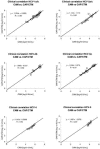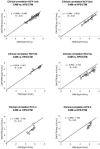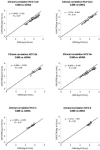Comparison of conventional PCR with real-time PCR and branched DNA-based assays for hepatitis C virus RNA quantification and clinical significance for genotypes 1 to 5
- PMID: 16517847
- PMCID: PMC1393102
- DOI: 10.1128/JCM.44.3.729-737.2006
Comparison of conventional PCR with real-time PCR and branched DNA-based assays for hepatitis C virus RNA quantification and clinical significance for genotypes 1 to 5
Abstract
The key parameter for diagnosis and management of hepatitis C virus (HCV) infection is HCV RNA. Standardization of HCV RNA assays to IU is mainly based on genotype 1 panels. Little is known about the variability of commercially available HCV RNA assays for quantification of different genotypes. Two real-time reverse transcription (RT)-PCR assays (COBAS TaqMan HCV Test for use with the High-Pure System [HPS/CTM] and COBAS Ampliprep/COBAS TaqMan HCV Test [CAP/CTM]), one standard RT-PCR assay (COBAS Amplicor HCV Monitor 2.0 [CAM]), and one signal amplification assay (Versant Quantitative 3.0 [branched DNA [bDNA]]) were compared for quantification of genotypes 1 to 5 (n = 108). Using CAM as a reference assay for genotype 1-infected patients, the mean interassay differences compared with CAP/CTM, HPS/CTM, and bDNA were 0.16, -0.13, and -0.48 log(10) IU/ml HCV RNA, respectively. Comparison of CAM with CAP/CTM, HPS/CTM, and bDNA for the remaining genotypes showed the following results, respectively: 2a/c, -0.24, -0.78, and -0.49; 2b, -0.21, -0.18, and -0.64; 3a, 0.13, -1.04, and -0.55; 4, -0.52, -1.51, and -0.05; and 5, -0.28, -1.00, and -0.24 log IU/ml HCV RNA. A correct decision for treatment discontinuation in genotype 1 patients at week 12 was possible only when the same assay was used at baseline and week 12. Comparison of CAM with the CAP/CTM assay showed equal quantifications of genotype 1, 2, 3, and 5 samples, while genotype 4 samples were slightly underestimated. For the HPS/CTM assay, a significant underestimation of the HCV RNA concentrations of genotypes 2a/c, 3, 4, and 5 was observed. For the bDNA assay, a constant lower quantification of genotypes 1 to 3 was detected.
Figures



Similar articles
-
Differences between two real-time PCR-based hepatitis C virus (HCV) assays (RealTime HCV and Cobas AmpliPrep/Cobas TaqMan) and one signal amplification assay (Versant HCV RNA 3.0) for RNA detection and quantification.J Clin Microbiol. 2008 Dec;46(12):3880-91. doi: 10.1128/JCM.00755-08. Epub 2008 Sep 17. J Clin Microbiol. 2008. PMID: 18799708 Free PMC article.
-
Evaluation of an automated, highly sensitive, real-time PCR-based assay (COBAS Ampliprep/COBAS TaqMan) for quantification of HCV RNA.J Clin Virol. 2008 Oct;43(2):162-8. doi: 10.1016/j.jcv.2008.06.013. Epub 2008 Aug 8. J Clin Virol. 2008. PMID: 18692434
-
Performance of two Real-Time RT-PCR assays for quantitation of hepatitis C virus RNA: evaluation on HCV genotypes 1-4.J Med Virol. 2010 Nov;82(11):1878-88. doi: 10.1002/jmv.21911. J Med Virol. 2010. PMID: 20872714
-
The Cobas AmpliPrep/Cobas TaqMan HCV test, version 2.0, real-time PCR assay accurately quantifies hepatitis C virus genotype 4 RNA.J Clin Microbiol. 2013 Apr;51(4):1078-82. doi: 10.1128/JCM.02004-12. Epub 2013 Jan 16. J Clin Microbiol. 2013. PMID: 23325825 Free PMC article.
-
Performance evaluation of the new Roche cobas AmpliPrep/cobas TaqMan HCV test, version 2.0, for detection and quantification of hepatitis C virus RNA.J Clin Microbiol. 2013 Jan;51(1):238-42. doi: 10.1128/JCM.01729-12. Epub 2012 Nov 14. J Clin Microbiol. 2013. PMID: 23152551 Free PMC article.
Cited by
-
Multicenter evaluation of the new Abbott RealTime assays for quantitative detection of human immunodeficiency virus type 1 and hepatitis C virus RNA.J Clin Microbiol. 2007 Jun;45(6):1712-7. doi: 10.1128/JCM.02385-06. Epub 2007 Apr 4. J Clin Microbiol. 2007. PMID: 17409216 Free PMC article.
-
Direct quantitative analysis of HCV RNA by atomic force microscopy without labeling or amplification.Nucleic Acids Res. 2012 Dec;40(22):11728-36. doi: 10.1093/nar/gks953. Epub 2012 Oct 16. Nucleic Acids Res. 2012. PMID: 23074195 Free PMC article.
-
Hepatitis C RNA assay differences in results: Potential implications for shortened therapy and determination of Sustained Virologic Response.Sci Rep. 2016 Oct 20;6:35410. doi: 10.1038/srep35410. Sci Rep. 2016. PMID: 27762283 Free PMC article.
-
Role of HCV Viremia in Corroborated HCV Transmission Events Within Young Adult Injecting Partnerships.Open Forum Infect Dis. 2019 Apr 25;6(4):ofz125. doi: 10.1093/ofid/ofz125. eCollection 2019 Apr. Open Forum Infect Dis. 2019. PMID: 31041340 Free PMC article.
-
Evaluation of the Abbott investigational use only RealTime hepatitis C virus (HCV) assay and comparison to the Roche TaqMan HCV analyte-specific reagent assay.J Clin Microbiol. 2009 Sep;47(9):2872-8. doi: 10.1128/JCM.02329-08. Epub 2009 Jul 22. J Clin Microbiol. 2009. PMID: 19625475 Free PMC article.
References
-
- Afdhal, N., E. Godofsky, J. Dienstag, V. Rustgi, L. Schick, D. McEniry, X. J. Zhou, G. Chao, C. Fang, B. Fielman, M. Myers, and N. Brown. 2004. Final phase I/II trial results for NM283, a new polymerase inhibitor for hepatitis C: antiviral efficacy and tolerance in patients with HCV-1 infection, including previous interferon failures. Hepatology 40(Suppl. 1):726A.
-
- Beld, M., R. Sentjens, S. Rebers, C. Weegink, J. Weel, C. Sol, and R. Boom. 2002. Performance of the new Bayer VERSANT HCV RNA 3.0 assay for quantitation of hepatitis C virus RNA in plasma and serum: conversion to international units and comparison with the Roche COBAS Amplicor HCV Monitor, version 2.0, assay. J. Clin. Microbiol. 40:788-793. - PMC - PubMed
-
- Berg, T., C. Sarrazin, E. Herrmann, H. Hinrichsen, T. Gerlach, R. Zachoval, B. Wiedenmann, U. Hopf, and S. Zeuzem. 2003. Prediction of treatment outcome in patients with chronic hepatitis C: significance of baseline parameters and viral dynamics during therapy. Hepatology 37:600-609. - PubMed
-
- Dalgard, O., K. Bjoro, K. B. Hellum, B. Myrvang, S. Ritland, K. Skaug, N. Raknerud, and H. Bell. 2004. Treatment with pegylated interferon and ribavarin in HCV infection with genotype 2 or 3 for 14 weeks: a pilot study. Hepatology 40:1260-1265. - PubMed
-
- Davis, G. L., J. B. Wong, J. G. McHutchison, M. P. Manns, J. Harvey, and J. Albrecht. 2003. Early virologic response to treatment with peginterferon alfa-2b plus ribavirin in patients with chronic hepatitis C. Hepatology 38:645-652. - PubMed
Publication types
MeSH terms
Substances
LinkOut - more resources
Full Text Sources
Miscellaneous

